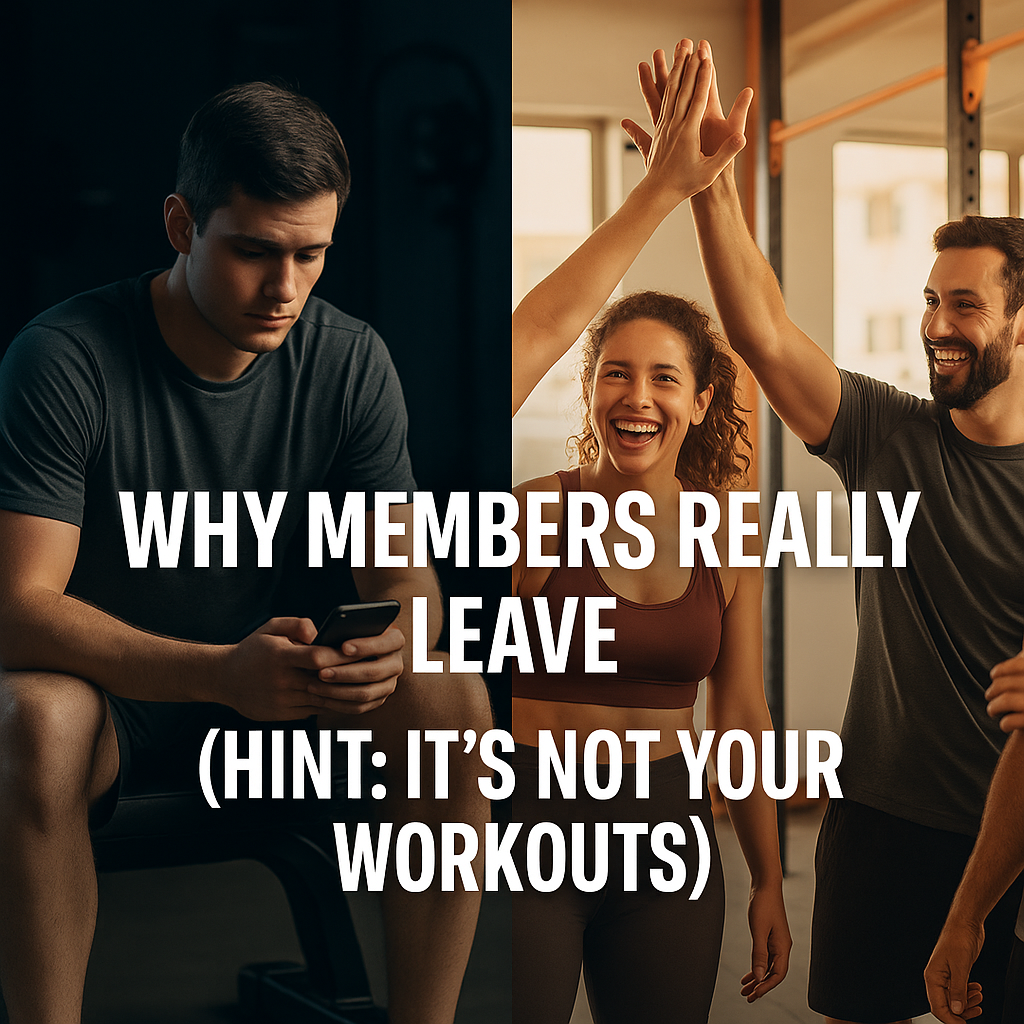The Hidden Reason Your Gym Members Keep Leaving (It's Not What You Think)
Your equipment isn’t the problem. The real reason members leave your gym? They feel invisible. Learn how to build a true fitness community that slashes churn and skyrockets retention.

If you're losing sleep over member churn rates, you're focusing on the wrong problem. After analysing member retention data from hundreds of gyms, we've discovered that the real reason people cancel their memberships has nothing to do with your equipment, pricing, or even your coaching quality.
The shocking truth? Most members don't leave because they're dissatisfied with your service—they leave because they feel invisible in your community. Today, we'll reveal the hidden psychology behind member retention and the simple framework that can slash your churn rate by up to 60%.
The Membership Lifecycle Lie
The fitness industry has been telling the same story for decades: members join with enthusiasm, attendance drops after six weeks, and they cancel within six months. This narrative has become such accepted wisdom that most gym owners treat high churn as inevitable.
This mindset is not only wrong—it's costing you thousands in lost revenue and making your business unnecessarily stressful. Gyms with exceptional retention rates (85%+ annual retention) don't have better equipment or lower prices. They understand something fundamental about human psychology that most gym owners miss entirely.
The Real Reason Members Leave: The Invisibility Factor
After surveying over 2,000 former gym members across different demographics and price points, the number one reason for cancellation wasn't "too expensive" or "not seeing results." It was: "I didn't feel like anyone would notice if I stopped coming."
This finding revolutionises how we should think about member retention. People don't just want access to equipment and classes—they want to feel seen, valued, and missed when they're absent. They want to belong to a community, not just pay for a service.
This psychological need for recognition and belonging is hardwired into human nature. When members feel invisible, they begin to justify leaving because they convince themselves their absence won't matter to anyone.
The Three Stages of Member Invisibility
Understanding how members become invisible helps you intervene before they reach the point of cancellation:
Stage 1: The Honeymoon Fade (Weeks 2-6)
New members start with high enthusiasm but begin to feel overwhelmed by the gym environment. They're unsure about equipment, intimidated by experienced members, and uncertain about proper form. Without proactive intervention, they start attending less frequently.
Warning signs: Decreased check-in frequency, decreased attendance, avoiding busy periods, not participating in group activities.
Stage 2: The Drift (Weeks 6-16)
Members settle into irregular attendance patterns. They've learned the basics but haven't formed meaningful connections with staff or other members. They become "ghost members"—paying but barely participating.
Warning signs: Sporadic attendance, never asking questions, declining class participation.
Stage 3: The Justification (Weeks 16+)
Members begin rationalising their lack of engagement. They tell themselves they're too busy, the gym is too crowded, or they're not seeing results. In reality, they've never felt truly integrated into the gym community.
Warning signs: Extended absences, making excuses about schedule conflicts, expressing dissatisfaction with minor issues, avoiding staff interaction.
The Community Integration Framework
Preventing member invisibility requires systematic community integration from day one. This isn't about being artificially friendly—it's about creating genuine touchpoints that make members feel valued and noticed.
Level 1: Recognition Systems
Simple recognition creates immediate belonging. This includes:
- Personal greetings using members' names consistently
- Acknowledging attendance milestones publicly
- Celebrating personal records and achievements
- Remembering personal details shared in conversations
- Following up on goals discussed in previous visits
The key is consistency across all staff members, not just when the owner is present.
Level 2: Connection Facilitation
Help members build relationships with each other through:
- Strategic introductions between compatible members
- Small group challenges that encourage interaction
- Social events that extend beyond workout sessions
- Mentor-buddy systems pairing new and experienced members
- Online community spaces for continued connection
Members who form friendships at your gym have retention rates 3x higher than those who don't.
Level 3: Progress Partnership
Transform your role from service provider to progress partner by:
- Regular check-ins about goals and challenges
- Personalised program adjustments based on progress
- Celebrating improvements in strength, health, or confidence
- Providing education that extends beyond the workout
- Connecting fitness progress to broader life improvements
When members see you as invested in their success, they become emotionally attached to continuing their journey with you.
The Retention Multiplication Effect
Here's what most gym owners don't realise: preventing invisibility doesn't just reduce churn—it multiplies the value of every member. Highly engaged members:
- Stay 3x longer than disengaged members
- Spend 2x more on additional services
- Generate 5x more referrals
- Require less customer service attention
- Become advocates who defend your business online
This means that investing in community integration doesn't just prevent losses—it dramatically increases lifetime customer value.
Implementation Without Overwhelm
The community integration framework might seem resource-intensive, but it's actually more efficient than constantly acquiring new members to replace those who leave. Here's how to implement it systematically:
Week 1: Recognition Foundation Train all staff on name usage and basic member recognition. Create systems for tracking member preferences and personal details.
Week 2-4: Connection Systems Implement one new connection activity weekly: introductions, challenges, or social elements.
Week 5-8: Progress Partnerships Develop check-in schedules and progress tracking systems that create regular meaningful interactions.
The key is consistency over intensity. Small, regular touchpoints are more effective than grand gestures that can't be sustained.
Measuring What Matters
Stop obsessing over monthly churn rates and start tracking leading indicators of member engagement:
- Average visits per member per month
- Percentage of members who know three other members' names
- Response rates to community events and challenges
- Number of meaningful staff interactions per member visit
- Social media engagement and gym-related posts
These metrics predict retention problems weeks before they show up in cancellation data.
The Compound Effect of Community
Gyms that master community integration create a compound effect. Engaged members become recruiting ambassadors, reducing marketing costs. They stay longer, increasing lifetime value. They participate more, creating energy that attracts others. They provide feedback that improves services, creating better experiences for everyone.
Most importantly, they transform your gym from a place people go to a community they belong to. And people don't leave communities—they invest in them.
Your Retention Revolution Starts Now
The next time a member cancels, don't ask yourself what service you failed to provide. Ask yourself: "Did this person feel seen and valued in our community?" The answer will reveal whether you're running a gym or building a movement.
Remember, your competition can copy your equipment, match your pricing, and hire similar coaches. But they can't replicate the genuine community connections you build with intentional effort over time. That's your sustainable competitive advantage—and the key to retention rates that make your business truly profitable.
Why 80% of Gym Owners Struggle to Scale Past £10K Monthly Revenue (And the 5-Step Framework That Changes Everything)
Most gym owners plateau at £10K/month—not due to lack of effort, but broken systems. Discover the 5-pillar framework that transforms chaos into scalable growth and turns coaches into business leaders
The 7-Figure Gym Owner's Daily Schedule: How Top Earners Structure Their Time (And Why Most Gym Owners Do the Opposite)
Discover how top gym owners earn more by working smarter, not longer. This post reveals the daily schedule that drives 7-figure success in the fitness business.


